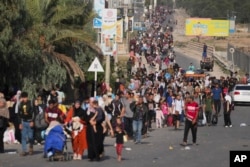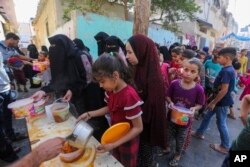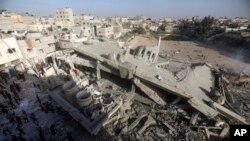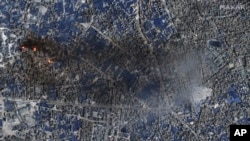Israel’s military said Wednesday that Hamas fighters had lost control of the northern part of the Gaza Strip, and that tens of thousands of Palestinians were fleeing to southern Gaza in search of safety.
"We saw 50,000 Gazans move from the northern Gaza Strip to the south. They are moving because they understand that Hamas has lost control in the north," Israeli Rear Admiral Daniel Hagari said in a televised briefing. "Hamas has lost control and is continuing to lose control in the north."
On Sunday, Israel began opening an evacuation corridor along the main road connecting the north and south of Gaza. It remains open for four hours daily to allow civilians to leave the epicenter of fighting. The IDF said Wednesday that it extended the corridor for an additional hour because so many people were using it.
The U.N. agency that assists Palestinians, UNRWA, said that since the corridor opened Sunday, at least 40,000 people have moved south, most of them on foot. UNRWA said these include children, the elderly and people with disabilities, many with just a few belongings. The U.N. and other aid groups are providing them with water and high-energy biscuits just south of the line separating north and south.
Conditions have been growing more dire in the north, which has been out of reach of aid deliveries for the past week. The U.N. said that as of Tuesday, no bakeries were operating there because of a lack of fuel, water, wheat flour and damage to their premises.
Israel launched its offensive in response to Hamas’ October 7 terror attack in southern Israel that killed more than 1,400 people, mostly civilians. Hamas also took about 240 people hostage. The U.S., U.K., EU and other countries in the West have designated Hamas a terrorist organization.
The Hamas-run health ministry in Gaza said Israeli attacks have killed more than 10,500 people, two-thirds of them women and children. There is no way to independently verify those numbers, though the U.N. says the ministry’s numbers have been reliable in the past.
Dire conditions
The U.N. has warned of overcrowding in southern Gaza with shelters “unable to accommodate new arrivals.” About two-thirds of Gaza’s 2.3 million residents are displaced, according to the U.N., and they face worsening sanitary conditions and a lack of water and fuel. At one shelter in Khan Younis housing 22,000 displaced Palestinians, the U.N. says at least 600 people are sharing a single toilet.
The World Health Organization said Wednesday that the risk was growing in Gaza for the rapid spread of infectious diseases, as bodies decompose under building rubble and health, water and sanitation systems have been severely disrupted. Cases of diarrhea in small children have skyrocketed; scabies, lice, skin and upper respiratory infections also have been on the rise.
Limited aid deliveries have reached Gaza through Egypt during the past 2-1/2 weeks, including 81 trucks on Tuesday with food, medicine, health supplies, bottled water and hygiene products. The U.N. said that before the conflict began there were an average of 500 commercial and aid trucks going into Gaza each day. Since October 21, there have been a total of 650.
WHO and UNRWA said Wednesday that they facilitated the delivery of emergency medical supplies to al-Shifa hospital in Gaza City, despite “huge risks to our staff and health partners” because of the bombing. It was only the second delivery of supplies to the hospital since the war began, and the agencies said it was insufficient to meet the immense needs. Israel accuses Hamas of concealing its command center under al-Shifa.
The U.N. said about 600 foreign and dual nationals left Gaza through the Rafah border crossing with Egypt on Tuesday. The government of the Philippines said about 40 of its nationals were on their way home. Ukrainian President Volodymyr Zelenskyy said the first group of Ukrainians to flee Gaza were safe in Egypt, along with 36 citizens from neighboring Moldova.
U.N. Human Rights Commissioner Volker Türk was at the Rafah crossing Wednesday, which he called “the gates to a living nightmare.”
“The collective punishment by Israel of Palestinian civilians amounts also to a war crime, as does the unlawful forcible evacuation of civilians,” he said. “The massive bombardments by Israel have killed, maimed and injured in particular women and children.”
He also condemned as atrocities the actions of Hamas on October 7, saying their terror attack and the holding of hostages were also war crimes.
“We have fallen off a precipice. This cannot continue,” he said, appealing for a humanitarian cease-fire.
Foreign ministers from the Group of Seven leading industrial nations issued a joint statement supporting Israel’s right to self-defense and calling for humanitarian pauses to allow aid to reach Palestinian civilians in Gaza.
U.S. Secretary of State Antony Blinken said those calling for an immediate cease-fire in the conflict “have an obligation to explain how to address the unacceptable result that would likely bring about: Hamas left in place with more than 200 hostages, with a capacity and stated intent to repeat October 7th again and again and again.”
He outlined several elements that the United States believes are key to lasting peace and security in the region, including barring forcible displacement of Palestinians from Gaza; not allowing Gaza to be used as a source of attacks; not allowing Israeli reoccupation of Gaza following the conflict; barring attempts to blockade Gaza; and ensuring no terror threats can come from the West Bank.
VOA U.N. Correspondent Margaret Besheer contributed to this report. Some information came from The Associated Press, Reuters and Agence France-Presse.















